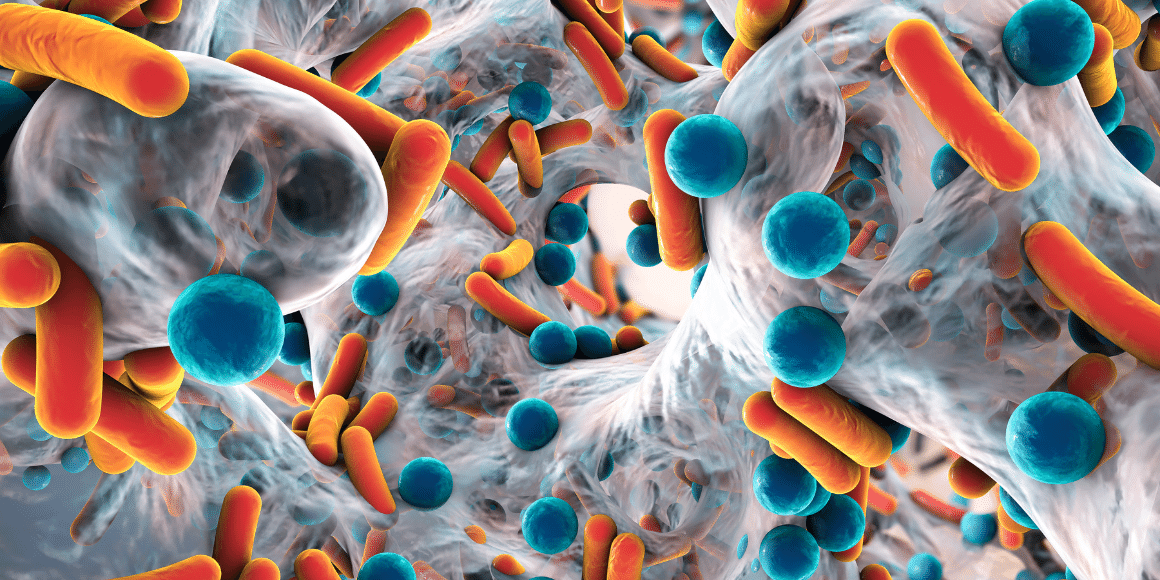Maintaining food safety and quality assurance (FSQA) is a demanding job, and one of the biggest challenges is combating an invisible threat of biofilm. In addition to potentially contaminating food with unwanted pathogens, biofilms can also cause premature wear and failure of equipment. As with all types of bacteria and pathogens, taking a proactive approach is the best way to avoid biofilm formation. But when a biofilm does form, it’s crucial to know how to address it.
What Are Biofilms and How Are They Formed?
First, we need to define biofilms. Biofilms are colonies of microorganisms—including some of the most common foodborne pathogens—that form on a surface. Unlike free-floating bacteria that are relatively easy to remove with disinfectants, biofilms form a protective layer of extracellular polymeric substances that make them more challenging to remove.
How Do Biofilms Form?
Biofilms form in five steps:
-
- The reversible attachment to a surface—this is when intervention is key.
- The formation of a single layer and production of a protective matrix.
- The formation of a microcolony with multiple layers.
- The maturation and growth of the biofilm within the protective matrix.
- The proliferation of pathogens dispersed from the biofilm to form new microcolonies and repeat the process.
Within the protective barrier, the pathogens have access to air, water, and nutrients, so they continue to thrive and grow. Biofilms tend to form in areas that are more difficult to treat, including:
-
- Drains
- Walls
- Backsides of equipment
- Scratches on work surfaces
- Refrigerator and freezer coils
- Animal drinking water lines
Biofilms can form on almost any surface, including metal, concrete, glass, rubber, steel, and wood. That’s why food processing environments are so susceptible to biofilms.
How to Identify Biofilms
Biofilms often cannot be seen by the naked eye, so you must take a proactive approach to remove them before they spread. Sensory tests—including visual inspection, the presence of odors, and different textures—can indicate biofilm formation but should not be the only detection method. Environmental swabbing can help you identify areas of concentrated bacteria, so test frequently in areas of concern. It’s important to know that biofilms can form in a range of extreme environments, including cold storage and freezers, so it’s critical to test at every step of the supply chain.
How to Treat and Avoid Biofilms
Proactive prevention is always a better approach than reacting to biofilm formation. During daily sanitation, pay special attention to areas where biofilms are more likely to grow. By removing the free-floating bacteria that can potentially form into a biofilm, you can avoid a larger problem in the future.
Is biofilm dangerous?
Due to the nature of biofilms being difficult to identify and remove, biofilms can cause contamination before you even realize you have a problem.
If biofilm is identified, specialized treatment is necessary for effective removal. Your usual disinfectants might not work unless they include a label claim for biofilm removal. Depending on the product, you might also need to use mechanical scrubbing to disrupt the outer layer of the biofilm to reach the pathogens within. The key to effective treatment is the complete removal of the protective matrix. If this is left behind, the biofilm will form again.
D7 for Biofilm Treatment
D7 is a patented sanitizer and disinfectant that is EPA-approved for biofilm removal in food processing plants and animal drinking water lines.
Sanitizing and Disinfecting
D7 foam expands to fill hidden spaces and tiny crevices to kill free-floating bacteria before biofilm can form. The foam clings to walls and vertical surfaces to ensure the D7 stays on for the minimum recommended contact time. The foam is also visible, so it’s easy to see where it has been applied and what areas were missed.
Biofilm Removal
Because of its unique formulation, D7 effectively removes biofilms from surfaces with no mechanical action required. D7 disrupts the protective matrix with detergents in the formulation and kills bacteria at the DNA level. By using D7 for biofilm removal, you can eliminate the need for hand-scrubbing, minimizing overall labor costs.
Biofilms can also cause premature wear and failure of equipment, so in addition to addressing safety concerns, proper treatment and removal can maintain the longevity of equipment.
By using D7 for daily sanitation and deep cleans, you can not only reduce the risk of biofilm formation, but also save time and money. With easy application, short contact times, and visible foam that does the work for you, D7 is a smart solution for FSQA managers who want to maintain strict sanitation standards while maximizing production time.
Learn how one company increased production and saved millions by reading our poultry farm case study.



